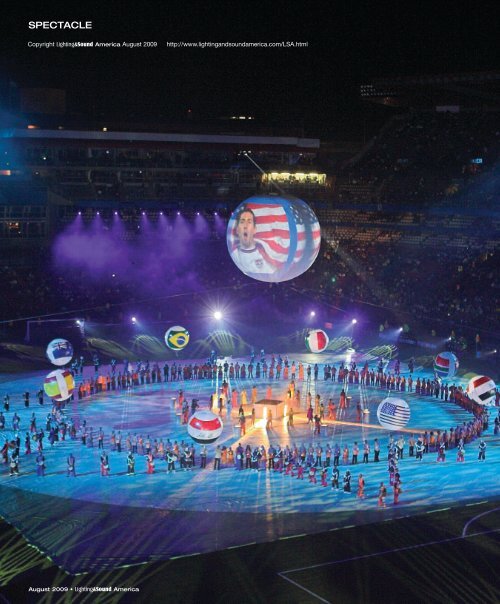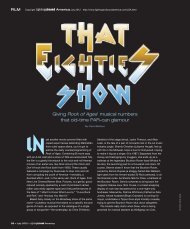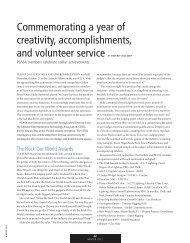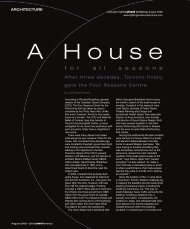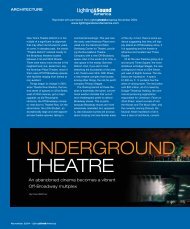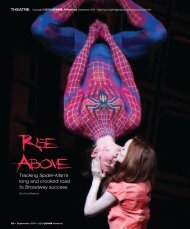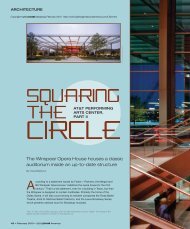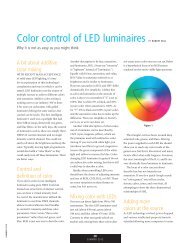You also want an ePaper? Increase the reach of your titles
YUMPU automatically turns print PDFs into web optimized ePapers that Google loves.
SPECTACLECopyright <strong>Lighting</strong>&<strong>Sound</strong> <strong>America</strong> August 2009http://www.lightingandsoundamerica.com/<strong>LSA</strong>.htmlAugust 2009 • <strong>Lighting</strong>&<strong>Sound</strong> <strong>America</strong>
A top soccer event provides South Africawith its moment on the world stageBy: Louise Stickland Photography: Louise Sticklandhe excitement of 53,000 enthusiastic football fans packed into EllisPark stadium in Johannesburg, South Africa was amazing—even ifyou weren’t football-mad. The crowd braved sub-zero temperaturesto witness the thrilling final match of the 2009 FIFA ConfederationCup on June 28.Held every four years by FIFA (the Fédération Internationale deFootball Association, the international soccer organization), thetournament features the winners of the six FIFA confederationchampionships, along with the host country’s team, and the winnerof the previous FIFA World Cup. It is held the year before the WorldCup, and is considered to be a dress rehearsal for that event. Likethe World Cup, it rivets the attention of fans from all over the globe.Before they saw Brazil beat the USA 3-2 in a closely fought match,the audience—plus several million television viewers—were treated towww.lightingandsoundamerica.com • August 2009
SPECTACLEan equally exciting closing ceremony,produced by VWV/Till Dawn, with fulltechnical production—including sphericalprojections, customized ballooncontrol, lighting and audio design, andequipment, rigging and power—supplied by Gearhouse South Africa.The Confederation Cup is thelatest in a string of high-profilesporting events staged in SouthAfrica. As with all these occasions,the visibility of the opening andclosing ceremonies has taken on arole parallel in importance to thematch schedules, a benchmarkagainst which the rest of the worldcan judge a nation’s ability toproduce a spectacular event. Thiswas no exception.The VWV Consortium is a joint initiativebetween two of the country’s mostprolific production companies, VWVGroup and Till Dawn Entertainment,headed by Grammy-award winningartist Lebo M. (Among other things,Controlling the 8m-diameter helium-filled balloon was a major challenge.Lebo M. is also a Tony Award nominee,for his contribution to the score of themusical The Lion King.) GearhouseSouth Africa has worked closely withboth companies, and was chosen asthe technical partner to deliver theopening and closing ceremonies.The Gearhouse Group,encompassing nine companies, isdedicated to supplying all areas oftechnical production, and is thelargest and most comprehensive suchoperation in South Africa.GHSA has embraced the manyopportunities offered by the unfoldingpolitical and economic process ofSouth Africa, embracing the energy“ On the Thursday night before the show, whilebeing tracked into Ellis Park for the projectionline-up to start, the ball was caught by a gust ofwind in the parking lot and became impaled onone of the stadium’s concrete stanchions—causing a serious rupture. Reconstructive surgerytook 24 hours to complete, and the ball returnedto the field fit and healthy—but now with time foronly one end-of-show fly out rehearsal. ”and vibrance of the country and itspotential as a future powerhouse.The company has established itself ina unique position, developing aninter-departmental synergy,encouraging and sharing creative andtechnical expertise, and continuallyinvesting in the latest technology tofacilitate its work.The GHSA closing ceremony crewof up to 150, including locals, wasproject-managed by Bonni Meyer.They battled freezing cold nights andthe bitter wind chill of the SouthAfrican winter—and the stadium inparticular—working in an exceptionallytight time frame, getting in on Mondayfor a show the following Sunday. Theyalso had to negotiate the complexadministrative procedures involved inaccessing and working withinEllis Park.Mark Ransom, of JohannesburgbasedQA Entertainment Technology,came onboard as event technicalproduction manager.The pressure was really on forperfect execution of a 16-minuteshow designed to communicatequickly and directly to a pre-matchAugust 2009 • <strong>Lighting</strong>&<strong>Sound</strong> <strong>America</strong>
ceremony. After a few budget-drivenrevisions, the final design incorporatedapproximately 150 moving lights,lighting a 60m (197') circular performancearea in the middle of the field,with color grading to the extents of theplaying field. “The challenge of lightinglarge areas is always in producing theatricality,drama, and some intimacyon a large scale,” Turner notesWith only 16 minutes to make animpact and just one dress rehearsal—lit without having seen the show—itcame down to the expertise andknowledge of Turner and his lightingprogrammer/operator, Tim Dunn. (Thepair—known for their side-splittingbanter during programming sessionsrigged at the higher levels from thestadium roof on two sides. Creatingthe lighting positions themselves—asthey didn’t exist previously—was thetask of Gearhouse Rigging, inconsultation with Turner.It was vital that none of the flownlighting or metalwork obscure anyone’sview or cover any of the official FIFAbranding. <strong>Lighting</strong> also had to avoidspillage on the ball. This proved quite abrain-twister for the rigging department,which again rose to the challenge. Allplans for the bracketry, its attachmentto the concrete support barriers, andthe consequent horizontal pointsloading around the mezzanine levels,had to be submitted to and approvedBonni Meyer,project managerHugh Turner,lighting designerChris Grandin, ofGearhouse MediaSean Rosig,assistant lightingdesignerTim Dunn, lightingprogrammer/operatorIn total, cable runs consumed approximately 8,000m of mains cable.as much as their creative dynamics—could go on the road as a comedy actif they ever wanted a career change.)Dunn has lit a myriad of stadiumshows and several opening and closingceremonies, most recently in Mayfor the Indian Premier League Cricket,which was moved to South Africa atthe last minute. His experience in thefield was helpful in working inside thetight time fame.The air elements of the lighting rigfeatured 72 Martin Professional MAC2000 Wash units, rigged on custombrackets and trussing around the midlevelbalconies of the stadium on allfour sides, plus 24 Robe ColorWashand 12 Robe ColorSpot 2500E ATs,by the stadium’s structural engineers.They allowed 350kgs (771.5lbs) perpoint on the barriers, including thetrussing sections and lights. Thebrackets themselves comprised aU-channel that bolted on either side ofthe concrete wall, complete withadjustable outriggers, which pushedthe reach of the trusses out to 1m.To kick the light output across thefield, all the Macs were all fitted withPC lenses. The Robes on the toplevels were required for key and moodlighting in the mid-field area—anapproximately 80m (262.5') throw,“We needed a bright fixture with along throw capacity; the 2500s weregreat for the job,“ says Turner.Winch expert Charles Standing, withGearhouse Rigging's Pieter Joubert (center)and Kendall Dixon (right)Gearhouse audio crew: Tsepo “Big Baby”Matlala, France Malatjit, Tanya Brown, RevilBaselga, and Jako de Witwww.lightingandsoundamerica.com • August 2009
SPECTACLEAs with any large-scale show, theessence was about producing largepictures and statements while comprehensivelybathing the performancearea in light. Around the perimeter ofthe pitch were the main effectsfixtures—36 Mac 2000 Profiles, usedfor streaking the field with color andtextures, which looked exceptionallygood on the overhead camera shots.Twenty-nine bars of six PARs wereinstalled around the mid-levels, usedto skim the backs of the lower seatingbanks, adding ambience and color. Onthe field itself were just four PanavisionMaxi-Brutes (a VNSP PAR 64 four-litelinear blinder), positioned in the centerof the eight solo drummers whostarted the show, casting strikingcorridors of light amidst the cast. Thedrummers themselves were each uplitwith a PAR 64 at the base of theirclear-skinned drums.It was an expediently sized rig for astadium, but Turner and Dunn workedit intelligently and thoughtfully tocreate a harmonious and richlylayered light show that was totallyappropriate for the occasion.The 12 followspots—a mix ofStrong Entertainment <strong>Lighting</strong>Gladiators and Super Troupers—werecalled by Turner, and Sean Rosig, theassistant LD, was also involved inpre-production as well as on-site.After the show, Turner concluded,“It’s been a great experience and areal pleasure working with Mark andhis team and the Jack Mortonconsultants in particular.”AudioWhile the technical requirements werestraightforward in terms of equipment,precise and diligent execution waskey; this was managed by RevilBaselga and Jako de Wit fromGearhouse Audio.The cast of 350-odd choirmembers, drummers, and dancersperformed to multi-track playback,with six soloists singing live.After initial site visits, Baselgadecided the best option for the venuewas to utilize elements of the housesound system and integrate thesewith 18 L-Acoustics KUDO and 12V-DOSC speakers, all driven by LA8amps. Each L-Acoustics stackcontained three elements, laid outaround the pitch and configured tocover the lower seating sections.The house Electro-Voice system,with specific zones disabled, wasused to cover all the higher seatingstands, with both systems timealignedand balanced via SMAART togive even and audible sound aroundthe highly reverberant space. Six dV-DOSC enclosures were provided forthe soloist monitors along one side ofthe field, facing the Presidential Box.Jako de Wit ran the Yamaha M7console for the show. A SennheiserG2 IEM system was supplied for thesoloists, together with eight units ofShure PSM700 for the eight solodrummers. They also routed the FMtransmission for 20 principal membersof the choir. The soloist mics wereShure UHF Beta 58 handhelds.The biggest challenge for Baselgaand his crew was chipping the ice offthe speakers in the mornings andsourcing a fan heater for their front-ofhousegazebo, which soon literallybecame “hot” property, and wasstrategically shared with AV.PowerFor the closing, Gearhouse Powerinstalled two 800A supplies—one tothe north and one to the south side ofthe stadium, breaking down to four300A feeds at four points aroundthe stadium.The mains runs consisted of one200m (656') cable run to the northeastcorner, where the first 800A drop wassituated, and one 300m (984.25') cablerun to the southeast corner, where thesecond 800A drop was located.A further 150m (492') of cable wasrun to each of the northwest andsouthwest corners to provide the 300Afeeds to these points on the oppositesides of the stadium—in total, cableruns consumed approximately 8,000m(26,246.75') of mains cable. The threesets of generators were 2 x 200 KVAsfor audio and two sets of 3 x 300KVAs for the north and south end,feeding lighting and projection.The crew was comprised of fourelectrician and two generatorelectricians. The whole job wassupervised by power crew chief FodoMandla Mathe.One of the biggest logisticalproblems involved getting sufficientdiesel fuel into the stadium throughlog points and stadium shutdownsdue to match days. This meantdelivering diesel at 4am on match day.As with all the technical departments,many overnight shifts wereinvolved, as crew members workedaround the matches—which, along withconcern for the condition of the pitch,minimized rehearsal opportunities.The final whistleCreating and producing successfulshows and events is a key to SouthAfrica’s current economic restructuringand positioning itself as a commercialand leisure destination. It’s sometimeseasy to forget that it’s a young democracy,with just 15 years since the firstfree elections and disintegration of oneof the most despised and oppressivepolitical regimes in the world. It’s ahugely invigorating and inspiringexperience with which to be involved.Winning the 2010 World Cup tenderis boosting the entertainment/leisureindustry with the construction of ninenew stadiums and the first comprehensivepublic transit system in thecommercial center of Johannesburgand the state capital of Pretoria, whichhosted the recent inauguration ofSouth Africa’s fourth president, JacobZuma—a show also serviced byGearhouse South Africa.August 2009 • <strong>Lighting</strong>&<strong>Sound</strong> <strong>America</strong>


